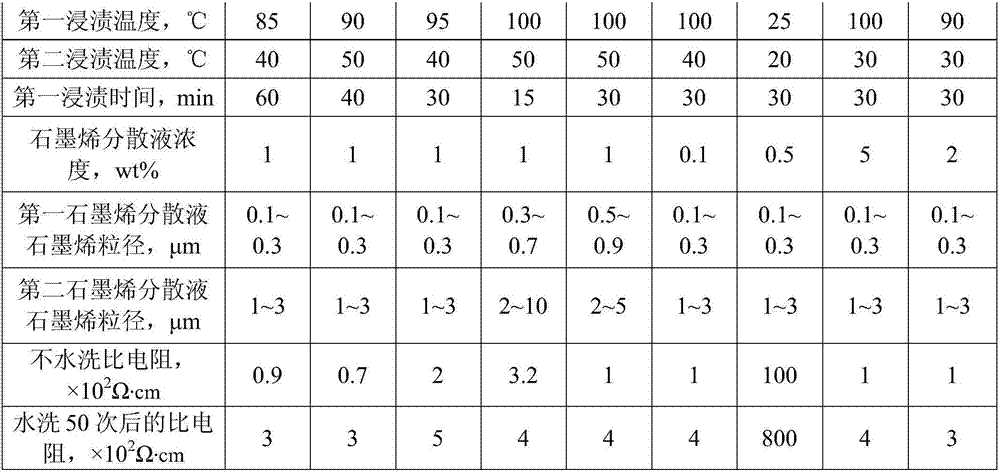Composite fiber, preparation method and applications
A composite fiber and fiber technology, applied in fiber processing, fiber type, textile, etc., can solve the problems of complex conductive polymer process, weak graphene adhesion, rough fabric feel, etc., to improve adhesion firmness and increase conductivity , Improve the effect of firmness
- Summary
- Abstract
- Description
- Claims
- Application Information
AI Technical Summary
Problems solved by technology
Method used
Image
Examples
Embodiment 1~9
[0071] A kind of composite fiber, concrete steps comprise:
[0072] (1) molten polymer, obtains as-spun fiber through melt-spinning;
[0073] (2) prepare the first graphene dispersion liquid, the particle size of graphene in the first graphene dispersion liquid is between 0.1~1 μm; prepare the second graphene dispersion liquid, graphite in the second graphene dispersion liquid The particle size of alkene is between 1 and 2 μm;
[0074] (3) the as-spun fiber of step (1) is immersed in the first graphene dispersion at the first temperature, then take out the fiber impregnated with the first graphene, and continue to immerse it in the second graphene dispersion for 30min, Thereafter, it was taken out and dried to obtain a composite fiber.
[0075] Performance test: The obtained modified fiber is tested according to GB / T 14342-2015; after that, the modified fiber is washed 50 times, and the washed modified fiber is continued according to GB / T 14342-2015 detection.
[0076] Tab...
Embodiment 10~13
[0081] A composite fiber, the difference from Example 7 is that nanocellulose (aspect ratio 80~120, diameter below 10nm) is dispersed simultaneously in the first graphene dispersion liquid described in step (2), and described nanocellulose is in The concentration in the dispersion liquid is 0.1wt%, 0.5wt%, 1wt%, 2wt%.
[0082] Using the same performance test method as in Example 7, the test results are shown in Table 2.
Embodiment 14
[0084] A composite fiber, the difference from Example 3 is that the first and second graphene dispersions are all replaced with graphene oxide dispersions, and the reduction step is carried out, specifically: in step (3) from the second graphene The fiber taken out from the dispersion liquid is put into a hydrazine hydrate reducing solution for reduction treatment, and then dried to obtain a composite fiber. Using the same performance test method as in Example 3, the test results are shown in Table 2.
PUM
| Property | Measurement | Unit |
|---|---|---|
| Particle size | aaaaa | aaaaa |
| Particle size | aaaaa | aaaaa |
| Particle size | aaaaa | aaaaa |
Abstract
Description
Claims
Application Information
 Login to View More
Login to View More - R&D
- Intellectual Property
- Life Sciences
- Materials
- Tech Scout
- Unparalleled Data Quality
- Higher Quality Content
- 60% Fewer Hallucinations
Browse by: Latest US Patents, China's latest patents, Technical Efficacy Thesaurus, Application Domain, Technology Topic, Popular Technical Reports.
© 2025 PatSnap. All rights reserved.Legal|Privacy policy|Modern Slavery Act Transparency Statement|Sitemap|About US| Contact US: help@patsnap.com


